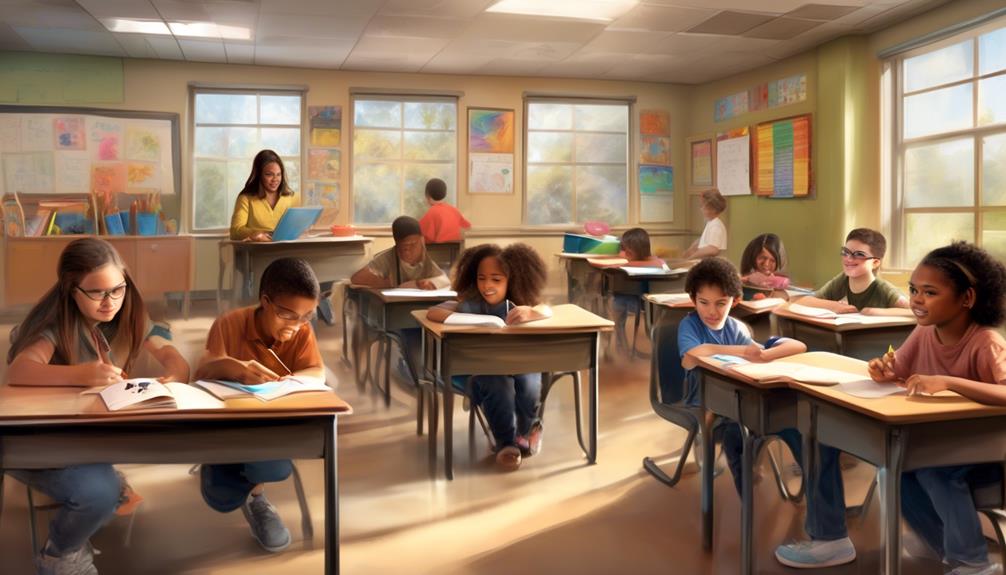What Is an Individualized Education Program (Iep) and Who Needs It?

An Individualized Education Program (IEP) is a personalized plan designed to meet the unique needs of students with disabilities, ensuring they receive the necessary support and accommodations for academic success.
This plan is for students who qualify and require additional support in the classroom.
What Is an Iep?
Are you curious about what an IEP is and how it can benefit you or your child's education? Well, let's dive into the fascinating world of Individualized Education Programs (IEPs).
An IEP is a personalized plan designed to support students with disabilities in reaching their educational goals. It's a crucial part of special education services that ensures students receive the necessary accommodations and modifications to thrive academically.
The IEP process begins with a series of meetings involving parents, teachers, and other professionals who work closely with the student. Together, they gather information, assess the student's needs, and develop a plan tailored to their specific requirements. These IEP meetings are a collaborative effort, bringing everyone's expertise to the table to create the most effective strategies.
During the meetings, goals are established, accommodations are determined, and progress is monitored regularly. The IEP is a dynamic document that can be reviewed and updated as needed to ensure it aligns with the student's changing needs. It serves as a roadmap for success, providing a clear path for educators to follow and support the student's academic growth.
Why Are IEPs Important?
Are you wondering why Individualized Education Programs (IEPs) are so important? Well, let me tell you!
IEPs offer a range of benefits to students with disabilities, such as tailored instruction, accommodations, and support services.
With an IEP in place, a team of dedicated professionals, including teachers, parents, and specialists, work together to ensure that each student's unique needs are met and that they've the best chance to succeed academically and socially.
Benefits of IEPs
IEPs play a crucial role in empowering students with individualized support and ensuring their educational success. By providing personalized education plans, IEPs address the unique needs of each student, allowing them to thrive academically and socially. Let's take a look at the benefits of IEPs in the table below:
| Benefits of IEPs | Description |
|---|---|
| Tailored Instruction | IEPs provide students with tailored instruction based on their individual strengths, weaknesses, and learning styles. This personalized approach maximizes their potential and fosters a love for learning. |
| Accommodations | IEPs offer accommodations such as extra time, preferential seating, or modified assignments. These accommodations level the playing field for students with disabilities, enabling them to participate fully in the classroom. |
| Progress Monitoring | IEPs include regular progress monitoring to track a student's academic growth and identify areas that need improvement. This allows educators and parents to make timely adjustments to support the student's success. |
With IEPs, students receive the targeted support they need, leading to improved academic outcomes, increased confidence, and a brighter future.
Role of IEP Team
The success of individualized education programs hinges on the collaborative efforts of a dedicated team. The IEP team, consisting of various professionals and individuals involved in the student's education, plays a crucial role in developing and implementing the program.
Here are three key dynamics of an effective IEP team:
- Open and Transparent Communication: Clear and open communication between team members is essential for successful IEP development. Regular meetings, discussions, and sharing of information ensure that everyone is on the same page and working towards the student's goals.
- Shared Responsibility: Each member of the IEP team has a unique role and contribution to make. By recognizing and valuing everyone's expertise, the team can work together to create an individualized plan that meets the student's needs.
- Collaborative Decision-making: The IEP team should promote a collaborative decision-making process, where all perspectives are considered. By involving all team members in the decision-making process, the IEP becomes a comprehensive and well-rounded plan that addresses all aspects of the student's education.
Who Qualifies for an Iep?
To determine if you qualify for an Individualized Education Program (IEP), we must assess your specific educational needs and challenges. Assessing eligibility and determining qualifications for an IEP is a crucial step in ensuring that students receive the appropriate support and accommodations they need to succeed academically.
The process begins with a comprehensive evaluation conducted by a team of professionals, which may include teachers, special educators, psychologists, and other specialists. This evaluation aims to identify any learning disabilities, developmental delays, or other conditions that may impact your ability to learn and participate in the general education curriculum.
During the evaluation, various assessments and observations will be conducted to gather information about your cognitive abilities, academic skills, social-emotional development, and physical functioning. The team will also review your educational records, conduct interviews with you and your parents, and seek input from other relevant individuals, such as previous teachers or therapists.
Based on the evaluation results, the IEP team will determine whether you meet the eligibility criteria for an IEP. In general, eligibility is based on the presence of a disability that significantly impacts your educational performance and requires specialized instruction and support.
If you qualify for an IEP, the team will develop an individualized plan tailored to your specific needs. This plan will outline the goals, accommodations, modifications, and related services necessary to support your educational progress and ensure equal access to the curriculum.
Assessing a Student's Need for an IEP
Assessing a student's need for an IEP involves a thorough evaluation of their educational abilities and challenges to determine the appropriate support and accommodations required for academic success. The assessment process is a crucial step in identifying the specific needs of a student and formulating an individualized education program.
Here are three key aspects of the assessment process that will help in identifying the needs of a student:
- Comprehensive evaluation: A team of professionals, including teachers, specialists, and parents, conduct a comprehensive evaluation of the student's academic performance, behavior, and social-emotional development. This evaluation may include standardized tests, observations, interviews, and review of academic records. The goal is to gather comprehensive information that provides a holistic view of the student's strengths and weaknesses.
- Individualized assessments: Individualized assessments are administered to target specific areas of concern. These assessments can include psycho-educational evaluations, speech and language assessments, occupational therapy evaluations, and others. By using these assessments, professionals can gain a deeper understanding of the student's unique needs and determine the appropriate interventions and accommodations.
- Collaboration and input: The assessment process also involves collaboration and input from various stakeholders, including parents, teachers, and specialists. Their insights and perspectives are invaluable in understanding the student's needs and developing an effective IEP. By working together as a team, everyone can contribute to creating a comprehensive and supportive educational plan tailored to the student's requirements.
Developing an Effective IEP
Developing an effective Individualized Education Program (IEP) requires a collaborative and strategic approach to ensure that each student's unique needs are met for academic success. To develop strategies that cater to the student's specific requirements, a team of professionals, including teachers, parents, and specialists, come together to create a comprehensive plan.
The first step is to gather relevant information about the student's strengths, weaknesses, and learning style. This information helps in identifying the areas that need improvement and the goals that need to be set.
Once the goals are established, the team works on developing strategies and accommodations that will support the student's learning. These strategies can include personalized instruction, assistive technology, modifications, and adaptive materials.
It's crucial to regularly evaluate the effectiveness of these strategies to ensure that they're meeting the student's needs. This evaluation involves tracking the student's progress, collecting data, and making adjustments as necessary.
Implementing an IEP in the Classroom
Are you ready to transform your classroom into a personalized learning environment?
By implementing classroom accommodations, you can create a space that meets the unique needs of each student.
With individualized learning goals, you can set targets that challenge and motivate your students to reach their full potential.
And by consistently monitoring their progress, you can ensure that they're making steady gains and receiving the support they need.
Get ready to witness the amazing growth and success of your students as you implement an IEP in your classroom.
Classroom Accommodations
Implementing an IEP in the classroom can significantly enhance the educational experience for students with unique learning needs. To ensure that these students thrive in an inclusive education environment, specific classroom accommodations are necessary. Here are three classroom strategies that can help create an optimal learning environment for students with an IEP:
- Flexible Seating: Providing students with a variety of seating options, such as cushions, standing desks, or stability balls, can promote focus and engagement. This accommodates the diverse sensory needs and learning styles of students.
- Visual Supports: Incorporating visual aids, such as charts, graphs, and schedules, can assist students in understanding and organizing information. Visual supports can provide clarity and structure, helping students with executive functioning difficulties.
- Differentiated Instruction: Tailoring instruction to meet each student's individual needs is crucial. By incorporating various teaching methods, materials, and assessments, teachers can ensure that all students are actively engaged and able to learn at their own pace.
Individualized Learning Goals
Creating personalized learning goals is vital in maximizing the effectiveness of an Individualized Education Program (IEP) in the classroom. Individualized learning plans allow students with special needs to receive a personalized education that meets their unique needs and abilities.
These goals are tailored specifically to the student, taking into account their strengths, weaknesses, and learning style. By setting individualized learning goals, teachers can provide targeted instruction and support, ensuring that students make progress and reach their full potential.
These goals can be focused on academic skills, social-emotional development, communication, or any other area that requires attention. With personalized education, students can experience success and gain confidence in their abilities, ultimately leading to improved academic outcomes and overall well-being.
Progress Monitoring
Now that you understand the importance of individualized learning goals, it's time to dive into the crucial process of progress monitoring within an Individualized Education Program (IEP) in the classroom. Tracking progress and collecting data are essential components of an effective IEP. Here are three reasons why progress monitoring is vital:
- Individualized Assessment:
Progress monitoring allows teachers to assess a student's growth and determine if they're making sufficient progress towards their goals. By collecting data regularly, educators can identify strengths and weaknesses, tailor instruction, and provide targeted support.
- Evidence-Based Decision Making:
Progress monitoring provides objective data that helps educators make informed decisions about instructional strategies and interventions. It ensures that interventions are evidence-based, effective, and tailored to the unique needs of each student.
- Accountability and Communication:
Progress monitoring enables teachers, parents, and other professionals to stay informed about a student's progress. It fosters accountability, facilitates collaboration, and allows for ongoing communication to ensure that everyone involved is working together to support the student's success.
Monitoring and Reviewing an IEP
Regularly assessing and adjusting an Individualized Education Program (IEP) is crucial for ensuring that it meets the unique needs of each student. Monitoring and reviewing an IEP allows educators to track progress and ensure that students are on the path to success.
Progress tracking is an essential part of monitoring an IEP. By regularly collecting data and evaluating student performance, educators can determine if the goals and objectives outlined in the IEP are being met. This information helps identify areas where additional support may be needed or where modifications to the plan may be necessary.
Monitoring and reviewing an IEP also provides an opportunity to assess student success. By analyzing the data collected and evaluating the student's progress, educators can determine if the current strategies and accommodations are effective. If not, adjustments can be made to better support the student's learning and growth.
Regular monitoring and reviewing of an IEP ensures that it remains a dynamic document that evolves with the student's needs. By regularly assessing and adjusting the plan, educators can maximize the student's potential and provide them with the necessary tools and support to succeed academically and socially.
Collaboration Between Parents and Educators in IEPs
As parents and educators join forces to support students with Individualized Education Programs (IEPs), a collaborative partnership emerges to ensure academic and social success.
The success of an IEP relies heavily on the collaboration between parents and educators. Here are three ways that parent-teacher collaboration, communication, and support can benefit students with IEPs:
- Regular Communication: Open and consistent communication between parents and educators is vital for the success of an IEP. By sharing information, concerns, and updates, both parties can work together to address any challenges and make necessary adjustments to the student's plan.
- Joint Goal Setting: Parents and educators should work together to set realistic and achievable goals for the student. By aligning their expectations and aspirations, they can create a more cohesive and effective IEP that caters to the student's unique needs and abilities.
- Sharing Resources and Strategies: Parents and educators bring different perspectives and insights to the table. By sharing resources, strategies, and techniques that have proven successful, they can enhance the student's learning experience and provide a consistent support system.
Frequently Asked Questions
How Long Does an IEP Last and Can It Be Changed or Modified Over Time?
You'll be thrilled to know that an IEP can last for the entire school year! And guess what? It can totally be changed or modified over time to meet your ever-evolving needs. How awesome is that?!
Can a Student With a Disability Participate in Extracurricular Activities With the Support of an Iep?
Yes, a student with a disability can participate in extracurricular activities with the support of an IEP. It provides individualized accommodations and modifications to help them fully engage and thrive in these activities.
Are There Any Specific Laws or Regulations That Govern the Implementation of Ieps?
Implementing an IEP involves following specific laws and regulations. These govern the changes, modifications, and accommodations needed for extracurricular activities, standardized testing, and more. Resources, support groups, and involved parents and students can provide guidance and assistance.
Can Students With IEPs Receive Accommodations or Modifications During Standardized Testing?
You, as a student with an IEP, can absolutely receive accommodations and modifications during standardized testing. These supports are put in place to ensure that you have an equal opportunity to demonstrate your knowledge and abilities.
Are There Any Resources or Support Groups Available for Parents of Students With Ieps?
Looking for support? You're in luck! There are tons of resources and support groups available for parents of students with IEPs. You'll find a community that understands and can offer help and guidance.









